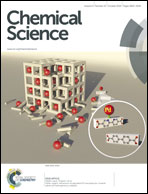Photo-induced uncaging of a specific Re(i) organometallic complex in living cells†
Abstract
In the last decades, a large number of organometallic complexes have shown promising anti-proliferative activity towards different cancer cell lines. However, these compounds generally had low cellular uptake and low selectivity towards cancer cells over healthy cells. The use of external triggers (e.g. light, ultra-sound, temperature, etc.) to modify the cytotoxic effect of a prodrug and the coupling of a targeting vector (e.g. peptides, antibodies, etc.) to a drug were found to be very successful techniques to tackle these drawbacks. Here, we envisioned combining these two methods, namely an external trigger (i.e. light activation) and a targeting vector, in an organometallic compound. More specifically, a Re(I) tricarbonyl N,N-bis(quinolinoyl) complex (Re-NH2) was derivatised with a photo-labile protecting group (PLPG) to cage Re-NH2 by formation of Re-PLPG. For organelle/cellular specificity, Re-PLPG was then further coupled to a nuclear localization sequence (NLS) or a bombesin peptide derivative to give Re-PLPG-NLS or Re-PLPG-Bombesin, respectively. Photolysis experiments in PBS buffer (pH 7.4) demonstrated that Re-NH2 was completely photo-released from Re-PLPG-NLS and Re-PLPG-Bombesin using a very low irradiation dose (1.2 J cm−2). To the best of our knowledge, these are the first two examples of the selective photo-release of an intact organometallic compound from a bioconjugate. Of high interest, both derivatives showed toxicity comparable to that of cisplatin towards cervical cancer cells (HeLa) upon light irradiation, although the phototoxic index (PTI) varied greatly with the targeting peptide. The cell death mechanism of Re-PLPG-NLS was explored using different techniques, including fluorescence microscopy, ICP-MS, gel electrophoresis, flow cytometry and transmission electron microscopy (TEM). It could be demonstrated that HeLa cells treated with Re-PLPG-NLS in the dark and upon irradiation showed severe cell stress (nucleolar segregation, pyknosis and vacuolation). The data obtained from an Annexin V/propidium iodide (PI) assay indicated that, after an early apoptotic stage, the onset induced by Re-PLPG-NLS led to cell death, with features ascribable to late apoptosis and necrosis, which were more marked for the treatment involving irradiation.


 Please wait while we load your content...
Please wait while we load your content...